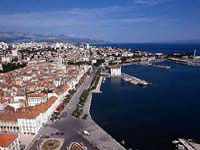 Split OverviewThe pretty city of Split has a rich history. Since ancient times
it has, in various guises, served as the economic and
administrative centre of the beautiful Croatian Adriatic coastal
region, today called Dalmatia. The city sits mainly on a peninsula
on the eastern part of the island of Ciovo, although it has
nowadays spread onto the mainland and encompasses the mouth of the
River Cetina. From the 5th to the 2nd century BC Greek colonists
settled the mainland and adjacent islands. Later came the Romans,
in particular the Emperor Diocletian, who, being of Dalmatian
origin, elected to build a huge palace at a spot then called
Salona, in the year 303. A town grew up around the palace, and
eventually, by the Middle Ages, the city of Split had begun to
develop. The Diocletian's Palace still stands in the very heart of the
old part of Split, which charms visitors with its cobbled streets
and Roman architecture. The greater Split area is characterised by
its lush vegetation and green areas, particularly Marjan Hill on
the west of the peninsula with its ancient indigenous forest. The
city makes an ideal base from which to explore the islands, beauty
spots, and historic villages in central Dalmatia. Split is also world renowned among seafarers for the quality,
and quantity, of its marinas. There are 44 of them in the city area
together, drawing yachts and catamarans from all over Europe and
making it a great cruising destination in the Adriatic. |